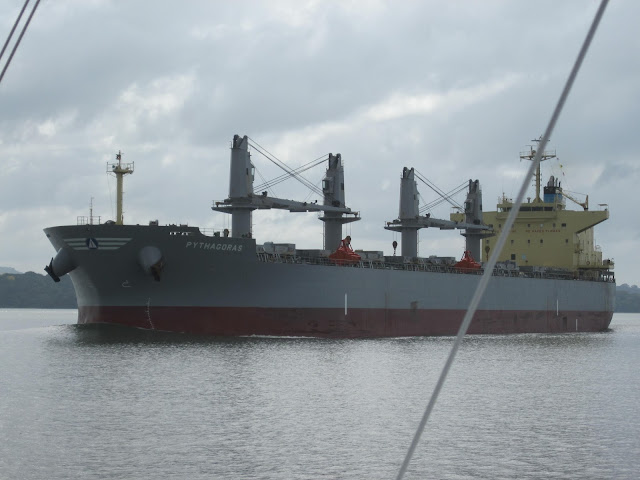 |
| Sunrise over Lake Gatun |
 |
| These tugs really push some water! |
We already
knew
that the Panama canal operates 24 hours a day. We really
understood it when, during the night, the boat was rocked by wakes
from the great big tugs plowing by. After a restless night, Chris and I were up
well before dawn, sitting outside listening to jungle sounds and looking
around. Nearby was a well-lit, artificial wall that seemed out of place.
However, we identified it later when an enormous container
carrier, escorted by several hefty tugs, exited – this was the lake end of the
new locks. The original lock chambers can accommodate ships with dimensions less
than 110 ft (33.53 m) wide, 1,050 ft (320.04 m) long, and
41.2 ft (12.56 m) deep. These new lock chambers – 180 ft
(54.86 m) wide, 1,400 ft (426.72 m) long, and 60 ft
(18.29 m) deep – can handle more (but not all) of the megaships now being
built, and just opened in June 2016. There were lots of birds to observe about the anchorage, as well as a couple of manatees and
a crocodile. Advisor # 2, Franklin, directed us along the channel through the
lake. It was odd to think that the little islands had been hilltops before the canal,
and that villages had existed on land that was now far beneath the water. In
the David McCullough book, he talks about the Culebra Cut and other areas that persistently fill in, and we saw evidence of that in the huge dredgers working
canalside. Two sets of locks at the southern end of the canal lowered us back down to sea level. Again, we tied to larger vessels, this time sight-seeing boats that take tourists through the canal. There’s a visitor’s center at the Miraflores locks, so we kind of
felt like we were under a microscope as we passed through…to the Pacific! Find more
info on the canal
here. Next time I'll tell you about a couple of the major obstacles that faced the builders of the canal.
 |
| Crocodile swimming past the defunct yacht club where we anchored for the night |
 |
| A megaship exiting the new, larger locks into Lake Gatun |
 |
| An adorable little island that used to be a hilltop |
|
 |
| All day it was a parade of huge ships passing by |
|
 |
| Tour boats ply the canal waters, giving people an up-close view |
|
|
 |
| Tying up to one of the tour boats in a lock chamber |
 |
| On the Pacific Ocean end of the canal, a view of the colorful Biodiversity Museum on the nearby Amador Causeway, the old city (Casco Viejo) farther away on the lower right, and the skyscrapers of modern Panama City in the distance |
 |
| Finally in the Pacific, we got to sail, and Chris was a happy man! |